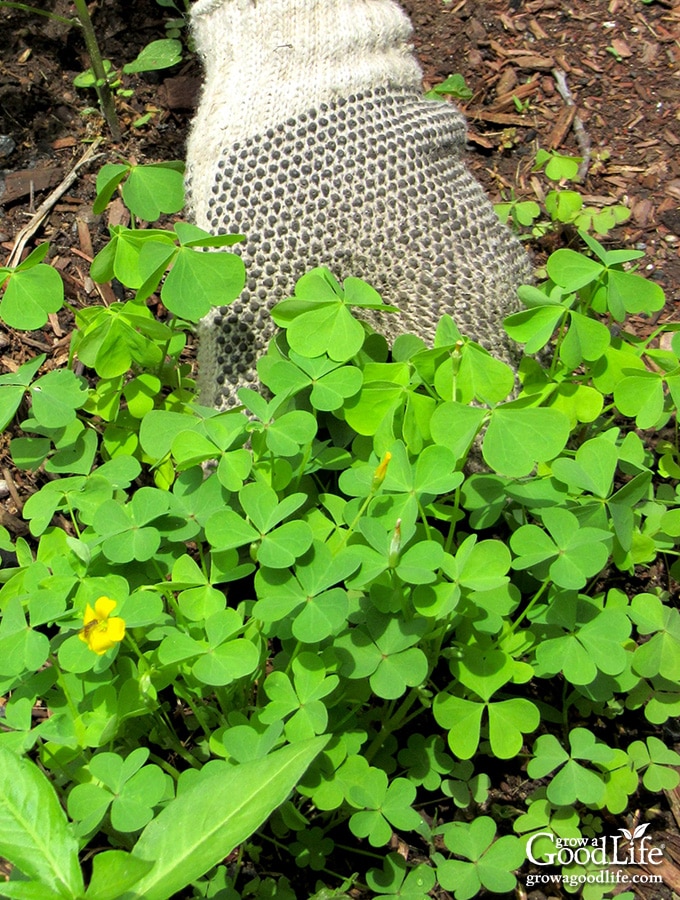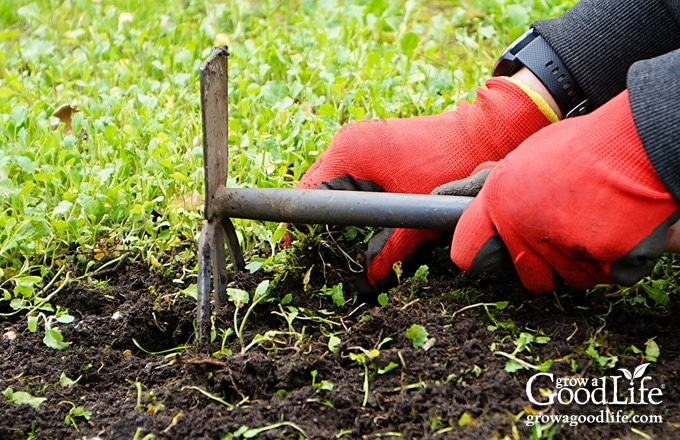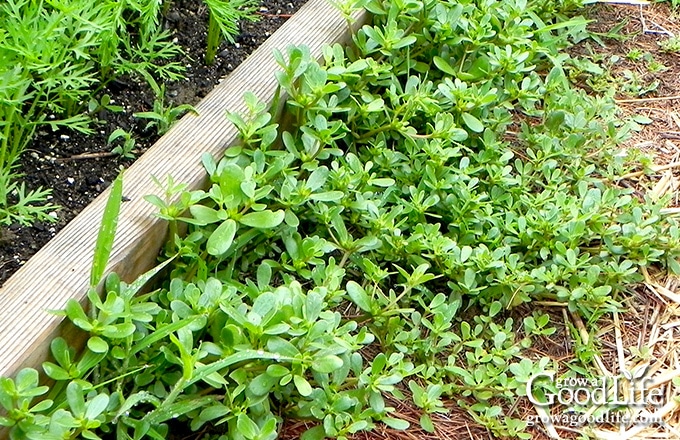Natural Weed Control in the Vegetable Garden
This post may contain affiliate links, which means that I may receive a commission if you make a purchase using these links. As an Amazon Associate I earn from qualifying purchases.
Weed control in an organic vegetable garden is a challenge that requires a few different approaches. Learn how to prevent weeds from taking over your vegetable garden.

A weed is considered to be any troublesome plant that grows abundantly where it is not wanted. The problem with weeds is they can compete with your vegetable plants for moisture, nutrients, and space.
Most garden soil contains weed seeds that are ready to sprout the moment they get enough light. Seeds can also be spread by animals, birds, wind, and by tracking them in on your shoes or clothing.
One of my least favorite chores is weeding the garden. I am guilty of often letting the weeds take over the garden at the end of the growing season. Many go to seed, and I have to be diligent to keep up with the weeding the following year. I have tried many ways to control weeds over the years and reduce the amount of weeding needed throughout the gardening season.
10 Tips to Help Control Weeds
There is no one-size-fits-all natural weed control method that knocks out all weeds and stops their re-emergence. Weeding is an on-going battle and typically requires a few different approaches to keep weeds from overtaking the vegetable garden.
It is impossible to have a completely weed free garden, but here are some steps that you can take to stop weeds from crowding your plants:
Start with a Weed Free Garden
Spring is a great time to clean up the garden. The garden is just waking from its winter slumber. The weather is cooler and more comfortable to work in the garden than hot humid summer days, and there are no black flies or mosquitoes buzzing around your head looking for blood.
I begin preparing the garden in early spring, as soon as the ground can be worked. First, I push last year’s mulch aside, go through each garden bed and remove all the weeds and grass.

Then, I work in a layer of finished compost into the soil surface. I leave the bed un-mulched so the soil can warm, and weed seeds on the surface sprout and begin growing. I remove these weeds just before planting, sow my seeds and plants, and then add mulch.
If you are starting a new garden with fresh, weed free soil you may not have that many weeds the first year. Prevention is going to be your goal to keep the weeds controlled throughout the growing season.
Add a Generous Layer of Mulch
Mulch is the best layer of defense against weeds in your garden. Organic mulch benefits the garden in several ways including, conserving moisture, keeping the soil cool, and suppressing weeds.
A thick layer of mulch prevents the sunlight from reaching the soil so the weed seeds are unable to germinate. The mulch will quickly suffocate the few seeds that do manage to sprout.
Begin with a weed free garden and apply a 4-inch layer of organic mulch on top of the soil. Organic mulch can be straw, wood chips, compost, shredded newspaper, pine needles, or leaf mold. You want something that will allow water to penetrate, but block sunlight from reaching the soil.

The mulch will also slowly decompose and increase the health of the soil. Healthy soil produces healthy plants and the stronger the plant the more able it is to naturally fight for the nutrients and moisture in the soil and cause weeds to die of starvation and dehydration.
Mulching the soil surface helps reduce the number of weed seeds that sprout, but you will still need to put some effort in weeding out the ones that do.
Avoid Disturbing the Soil
Your garden is filled with weed seeds, but only the ones at the top few inches will receive enough light to grow. Every time you dig in your garden, you will bring up more seeds to the surface of your soil.
Dig only when needed to sow seeds and transplant seedlings into the garden. Simply push the mulch aside, work in some compost, and plant your seeds and transplants. Once the plants become established, add more mulch keeping it a few inches away from the stems so you don’t smother the plants.
The old-timer’s way of rototilling the garden each year not only destroys the soil structure, but it also brings plenty of weed seeds to the surface to germinate. Consider establishing permanent garden beds and applying the no dig approach to gardening to build your soil instead of digging up fresh weed seeds each year.
Remove Weeds When Small
Pulling weeds early when they are small and have a shallow root structure is much easier than later when they are larger.
Any time you see a weed in the vegetable garden, take a few minutes and pull it up by the roots. A garden trowel or claw will allow you to get under the weed and extract the plant from the soil by the roots. Discard weeds away from the garden and do not add them to your compost bin.
The weeds can re-root easily and can re-emerge with a vengeance if the weed plant is tossed onto the compost pile or left in the garden. Weeds may have seeds that can remain dormant for years, and then sprout when conditions are right. Instead, toss weeds deep in the woods far away from your garden.
Develop a Weeding Schedule
To stay ahead of weeding, get into a routine of weeding the beds frequently, at least once a week. Divide the garden beds into groups and weed a couple of beds each session. This is much less overwhelming than taking on the task of weeding the entire garden at once.
The easiest time to weed is when the ground has dried out slightly after a rain. Weeds pull out of the soil more easily when the ground is marginally moist. Try to pull the roots out as well, because many weeds will regrow from roots left in the ground.
Pull weeds that have managed to sprout through your mulch. Carefully hand pull weeds that are growing close to your vegetable garden plants so you don’t disturb the roots. Use a trowel to dig out weeds with long taproots.
Remove Seed Heads
Weeds are opportunists and aggressive plants that can grow almost anywhere they can find space in your garden beds, along the paths, and in any areas nearby.
If you can’t keep up with the weeds when they are young, taking the time to cut off the tops before they go to seed will prevent thousands of seeds from spreading. Use a string trimmer to chop down weeds in your paths before they go to seed to help prevent them from self-sowing in your garden.

Don’t Leave Bare Spots
It doesn’t take long for weeds to invade and take over. Make sure every part of your garden is either planted or mulched. Plant cover crops in garden beds that are not in use, and chop it down before it goes to seed. Use cardboard covered by wood chips to help keep the weeds down in the garden paths between your growing beds.
Water the Plants, Not the Weeds
If you water your entire garden, you are giving weeds a perfect environment to sprout up and grow. Let open areas, such as paths and corners stay dry.
Instead, only add moisture where it is needed. Use soaker hoses, watering can, or hose with a spray nozzle to deliver moisture directly to the base of your plants. Water in the morning when the air is cool to minimize evaporation.
Identify Edible Weeds
Not all weeds are bad. I don’t mind a few dandelions or wild violets in my garden. Both the flowers and foliage are edible and often make their way into salads. The flowers also attract pollinators.
Purslane is a low growing succulent annual that tends to pop up in most corners of my garden. The leaves are edible and have a refreshingly crisp, slightly lemon flavor with a nice crunch that make a wonderful addition to any salad.

Other edible weeds include lamb’s quarters, chickweed, and watercress. I usually allow most edible weeds to stay as long as they are not crowding out other plants. Just be sure to remove them before they go to seed.
Weed Control Advice to Ignore
Weeding is one of the least favorite chores for many gardeners. Therefore, many of us will search for an easy solution to controlling weeds in our garden.
If you are growing an organic vegetable garden, you know to stay away from harsh chemical sprays and glyphosate herbicides, which contain long-term chemicals that can harm health and remain in the soil.
A quick search online will turn up a number of so-called “natural” weed killers using kitchen ingredients. The most common is a mixture of dish soap, vinegar, and salt.
Be careful if you choose to use a DIY weed killer in your vegetable garden. The vinegar will burn everything it comes in contact with including plants that are close by, beneficial insects, and toads. It is also unlikely to kill the weeds at the roots, so they will probably come back.
The dish soap contains chemicals that you may not want to add to your garden, and salt can harm earthworms and destroy the soil organisms that build healthy soil structure. Plus there is no way to know how long these chemicals will remain in your soil.
Some of these natural weed-killing recipes may not be good for your vegetable garden. However, feel free to try them to kill shallow weeds in between bricks and pavers on sidewalks and driveways away from the area you grow food.
—
Pesky weeds plague even the most well kept vegetable garden, and we must remain diligent to keep this formidable enemy at bay. The best natural weed control method for the home vegetable garden is one that works for you.
I have given you some tried-and-true methods of natural weed control that will not harm vegetable plants but are effective at preventing and getting rid of unwanted weeds. I hope you find a tip or two that works for you.
You May Also Like:
- Garden Mulching Advice from Seasoned Growers
- Time Saving Tips for Vegetable Gardeners
- Vegetable Gardening Tips for Beginners
Good planning is key to a successful vegetable garden
Whether you are new to growing your own food or have been growing a vegetable garden for years, you will benefit from some planning each year. You will find everything you need to organize and plan your vegetable garden in my PDF eBook, Grow a Good Life Guide to Planning Your Vegetable Garden.


Just FYI, the plant in the first picture (the one that looks similar to clover, with the yellow flower) is also edible! It’s called wood sorrel, and is deliciously sour.
Jane, Yes, wood sorrel is a very common weed in my garden and it IS edible.
Mulch mulch mulch! Yes, that is the absolute best thing to keep weed pressure down. I am so fortunate to have a source of used guinea pig bedding (shavings, droppings, Timothy hay) which is absolutely amazing in my garden.
If you run out of the bedding material you can use LANDSCAPE MATERIAL . I use it in all my raised gardens . and cheeper saw dust for in-between rows.
I actually don’t recommend landscape fabric even for the paths. Weeds end up growing though it over time and it breaks down into pieces that are difficult to remove. Instead, I suggest using broken down cardboard boxes covered by wood chips or sawdust. When cardboard breaks down, it ends up becoming a food source for worms and other organisms.
I love to read all your posts. To me you seem to live in a perfect gardening world. I live in Northern Nevada at the foot of the Sierras. We have harsh winters, hot summers and wind, lot of wind year round!
I have a small garden consisting of 3 – 4×8 raised beds and 3 round beds for pumpkins. I also pull small weeds as the come up. My big problem is the wind. I have tried bark, and straw for my paths. I can’t seem to get anything that doesn’t blow to the next county! The same is true for mulching in the beds and mounds. I just can’t get it to stay in place!
Another problem is regulating water. I seem to either get to much and my tomatoes crack or I get to much and the garden is a muddy mess. This year I think I will try soakers hose!
Oh the joys of gardening in Nevada!
Thanks for all your great posts and recipes too!
Carolyn, It may seem I have the perfect gardening world, but we all have our challenges. Over the years, my garden has become more shaded from trees around out property. Combine that with a short growing season and I have to really plan well to grow enough in a very short period of time. Have you tried using hardwood mulch made from tree trimmings? It is a little heavier and may stay in place better than straw. Unfortunately, constant wind is going to be a continuous challenge.